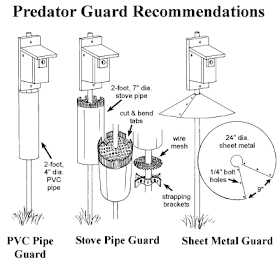Even though the
thermometer tells us that temperatures are still in the frigid zone, spring
will be upon us soon.
Spring means breeding
season for our feathered friends.
That being said, predators will soon realize that nestlings may be just
the easy snack that they have been longing for throughout the seemingly endless
winter. Each year I receive an
overwhelming number of calls from avid bird watchers, some horrified by the
thought of a snake or squirrel raiding the nest boxes, and asking how they can
protect the next boxes from these marauders.
These nestlings would make a tasty snack for a predator (photo: Adam Triska)
There are many predators
that commonly raid nest boxes including snakes, squirrels, raccoons, and
cats. The obvious way to avoid
predators would be to not place the box in an area that has prevalent
predators; but as we all know, especially us Missourians, sometimes this just
isn’t a possibility. Furthermore,
there are ways that you can prevent these predators from ravaging your nest boxes
and snagging an unsuspecting meal.
A good way to protect your
nest boxes from snakes is to create a predator guard out of a PVC pipe. With a PVC pipe and PVC cap you can
create a barrier that will not allow snakes to climb the pole leading to your
nest box to receive their tasty bounty.
First you will need to drill a hole into the cap allowing the cap to
snuggly slide onto the pole. Then
secure the PVC cap to the pipe using screws or caulk. This will create a barrier similar to the one pictured on
the left above. If you are not
feeling crafty or just aren’t the crafty type in general you can always
purchase one of these predator guards online.
If snakes are not the only
predator you have to fend off you may want to try the conical predator guard. This guard defends against nearly
anything that may want to disturb your nesting birds. These guards are most common for deterring raccoons. When the raccoon climbs the pole it
will try and reach around the cone and grip on to something in order to pull
itself up. This type of guard will
render it nothing but slippery sheet metal to grab hold of. After what is usually relentless
unsuccessful attempts the raccoon will eventually figure out that the work is
not equal to the reward and find food elsewhere.
This hardware cloth guard has stood up to the attacks of determined predators (photo: Gay Schroer)
Not all predator guards
have to be that complex. For those
of you who would like to create a simple guard for an area that does not see
quite as many predators a simpler predator guard may be the perfect solution. This type of predator guard is also
good for hanging nest boxes or nest boxes that are positioned on trees. This predator guard can be made out of
something as simple as hardware cloth.
The cloth is placed around the entrance of the box, as displayed in the
photo above, and then secured with screws in order to keep predators from
reaching into the box to gain access to its contents. Get creative and come up
with your own predator guard.
Sometimes you have to think outside the box!
Nest boxes can usually be purchased for a reasonable price at the Wildlife Hospital (photo: Gay Schroer)
The next time you visit
the World Bird Sanctuary you may purchase a nest box from the World Bird
Sanctuary Wildlife Hospital and help feed our birds with the proceeds! Pricing starts at only $2.00!
Submitted by Callie Plakovic, World Bird Sanctuary Outreach Coordinator






No comments:
Post a Comment